|
| Author |
Message |
eddienlinda
Member
|
# Posted: 27 Feb 2014 10:44pm
Reply
We are planning to have a rainwater catchment system when we build our place this summer. We know literally nothing except what we see in pics. Can you please give us detailed info regarding your system with pics please 
|
|
MtnDon
Member
|
# Posted: 27 Feb 2014 11:16pm - Edited by: MtnDon
Reply
check this manual
|
|
adakseabee
Member
|
# Posted: 28 Feb 2014 04:01pm
Reply
A couple of good references ...
|
|
eddienlinda
Member
|
# Posted: 28 Feb 2014 08:44pm
Reply
Lots of great info MtnDon and adakseabee. Great info!!!
|
|
ATB
Member
|
# Posted: 1 Mar 2014 08:01am
Reply
Thanks for the info I will read too. The Texas probably doesn't may but VA may discuss but what does one do in northern climates with rainwater harvesting in winter?
|
|
bldginsp
Member
|
# Posted: 1 Mar 2014 08:46am
Reply
--- From earlier post in another thread: ---
Posted: 26 Feb 2014 18:18 - by: bldginsp
I really like this
http://www.twdb.state.tx.us/publications/brochures/conservation/doc/RainwaterHarvesti ngManual_3rdedition.pdf
For the filters on my gutters, I used 'Gutter Glove' brand gutter guards, expensive but the best I've found.
I also made an elaborate filtration system inside my first flush diverter to ensure it will drain between rain events, which I will describe if asked. First you need to read up on first flush diverters in the Texas manual, if you don't know already what they are.
------
ATB- that's a problem. I designed my system to try to catch melting snow off the roof, but I don't think it catches much. You have to have a first flush diverter that, essentially, is always leaking in order to drain it between rain events, and since snow melt is a slow process, all your water goes out the diverter drain rather than into your tank. Whereas in rain enough is coming into the diverter despite the drain that it overflows into your tank.
Also if you are where there is snow you have to locate your gutter so that snow falling off the roof will not rip off the gutter. I built a shed with a 2 in 12 pitch so that it would hold snow, so the snow falling off the roof issue isn't relevant, but on larger buildings in snow country you can't do that. So, if you look where you have to locate the gutter on an 8 in 12 pitch roof so the snow will not rip the gutter, you'll see that it is so far below that some of the rain water will run off and miss the gutter too, but not all. I haven't tried this so I don't know how effective it is.
Where I am at 4000 feet in Northern Calif. there is substantial rain in fall and spring so my 2500 gallon tank is kept full, but I wonder how effective roof collection would be where most precip comes in the form of snow.
Then, if you are where there is a lot of freezing, you may need to bury the tank in the ground to prevent it freezing solid, but that's true regardless of water source obviously.
|
|
MtnDon
Member
|
# Posted: 1 Mar 2014 10:10am
Reply
Snow guards on the roof keep snow on the roof so it can be collected when it melts. They also save the gutters from being ripped off with sliding snow, which was their primary function.
The storage is the difficult part. How deep is the frost line? If the tank water is not that deep or deeper the water can freeze. Berming over can help but I've no idea if a foot of berming does as much good as a foot under the surface. Air bubbling also can slow down the freezing I think.
|
|
eddienlinda
Member
|
# Posted: 1 Mar 2014 10:24pm
Reply
So glad I we are in Texas.
|
|
|
eddienlinda
Member
|
# Posted: 1 Mar 2014 10:40pm
Reply
There is even a free 5 part course here.
http://rainwaterharvesting.tamu.edu/in-home-use/
Lots of great info
|
|
eddienlinda
Member
|
# Posted: 3 Mar 2014 04:57pm
Reply
http://www.screencast.com/users/TexasRWH/folders/Rainwater%20Harvesting%20for%20In-Ho me%20Use/media/8f0fe072-c736-42eb-87ba-7641abde2e71
Great presentation.
|
|
old243
Member
|
# Posted: 5 Mar 2014 10:25am
Reply
We don't use our camp much in the winter time, to get enough water for washing and dishes, use a large pot , fill it full of snow , sit it on the woodstove . keep filling up as it melts. Surprising how much water is in snow. Just be careful where you collect the snow, Don't want any yellow snow,  old243 old243
|
|
ILFE
Member
|
# Posted: 8 Mar 2014 01:51pm - Edited by: ILFE
Reply
Here is a very good video on rainwater harvesting, titled, Rain Barn I got my filter idea and advice from him, Mr. Billy Kniffen (Menard County, Texas) after communicating with via email.
I got an idea from LDSPREPPER, where he used a plastic water bottle in his first flush system. This prevented trash from flowing out of the system and into his tanks.
Here in Cambodia, we recently added more roof catchment area, an increase up to 55 square meters, to provide most of our water needs. I am about to add a 5,000 liter storage tank, and later this year a 10,000 liter tank, to supply us year round. So far, so good.
Almost forgot. It took a while, but we finally received our whole house activated charcoal filter. The filter alone, is 20" x 4.5". I'm hoping that is all the filtration the rainwater should need.
My apologies for the fotos. I have not taken any new images since the most recent upgrade to the rainwater harvesting project. The men in the image are working on the septic tank (believe it or not) before they finished adding the PVC to the downspout. We were in no hurry, as it had not rained in almost three months.
When I originally connected the pump, I was like a boy. I just wanted to check my system and see how well it worked.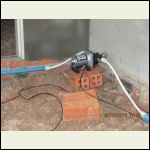
ShurFlo pump to provide water pressure.
| 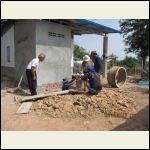
1050 Liter jar (background) & gutter up top.
| 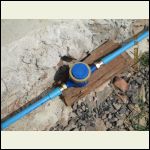
Water meter to keep track of our usage.
| 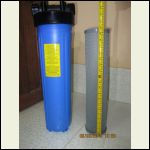
20" water filter housing.
|
|
|
eddienlinda
Member
|
# Posted: 10 Mar 2014 09:32pm
Reply
Nice work ILIFE. Looks like you have really thought things out
|
|
ILFE
Member
|
# Posted: 11 Mar 2014 10:26am - Edited by: ILFE
Reply
Thanks, fortunately, costs here are not too high. But, life is simple, too.
The metal roofing is $13 USD per square meter, installed. That includes them driving out 30 kilometers to do the installation. Not a bad job, and not one leak.
Image: you can see the concrete water jars ($25 USD each, delivered) the family has been using for storage. Prior to me adding the collection system, they just left the lids open for rain to fill the tanks. Took ages to fill them before. Now, one good day of rain and they are all over flowing. Three concrete jars are 3,150 liters, total. It will be good when we finally add the additional 15,000 liters that I want there.
You can see where the old downspout was, prior to adding the front porch roof. Again, a dated foto. Sorry about that.
There is a lot of work to be done to the little house. But, one step at a time.
|
|
TheWildMan
Member
|
# Posted: 11 Mar 2014 11:16am
Reply
my system is as cheap and simple as it gets, I nailed some cheap gutters up along any roof I could set them on. I had some salvaged 4" pvc pipe that I took a hand saw down the middle of to make a number of small gutters and set them overlapping for water to run down them (loops of old fence wire were used to hang them in place)
the water would run off the roof and into the gutter, run down the gutter and pour off the end and I would have a used food grade barrel (55 gallon plastic drum I got from an old resteraunt that had pickles delivered in them, I paid $15 each). the tops were just left open and water poured in till it was full, when it got close to the top I use a 5 gallon pail (free from a bakery that had frosting in them) to bail the water into the next barrel if there was another one close by. if I was worried about stuff getting in them I either cover the barrels with the lid (when they are full) and got framed screens from storm windows (found on the curb while out biking) that I set over the top of the collecting barrel.
to make it drinking water I use a funnel and a pitcher (made from a water jug) to fill empty clear plastic bottles and set them out to disinfect with the sodis method (solar UV disinfection giving microbes a sunburn to kill them). bath water, dish water, laundry water and water for the garden are taken out with 5 gallon pails and carried to where its needed.
this is about as cheap and simple as possible
|
|
TheWildMan
Member
|
# Posted: 11 Mar 2014 11:29am
Reply
by chance I have a picture of part of the setup. this is my fabrication shed (full of homemade tools like pitchforks made from forked saplings and mallets made from firewood with handles, also houses my forge, anvil, and a couple barrels full of homemade charcoal) its like most of the buildings around my off grid farm and made from whatever I could find and drag home. the 15 watt solar panel charges a battery I got from a friends car when it died and runs a couple lights. the shed is also used to store bags of fertilizer and junk metal for working on the anvil.
anyway I got these gutters on the curb and didn't have to make them (don't have a picture of those). the gutters and barrels are on both ends of the shed, I set out barrels anywhere I can since all my water comes from rain.
|
|
RMP
Member
|
# Posted: 23 Sep 2014 08:58am
Reply
Here's a small stand alone set-up next to my cabin that I put together a few months ago.
The rainwater first passes through a screen, then through a sediment filter which also contains a chlorine tablet, and then into the barrel.
It works well.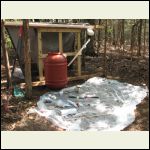
IMG_1723.JPG
| 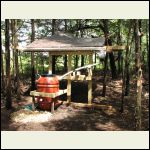
IMG_1768.JPG
| 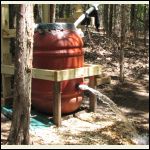
IMG_1822Mod2.JPG
|  |
|
|
|

